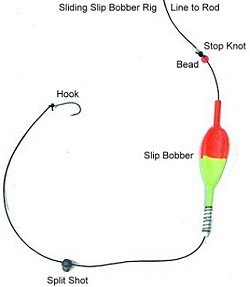|
The fun world of walleye fishing doesn’t require a huge investment. While many people prefer to fish from a boat, you can experience good walleye fishing while standing on shore or on a riverbank. Whether you fish from a boat or from shore, the equipment remains the same. Following are three popular methods used to catch walleyes.
When jigging, you will be moving the bait up and down to give it action. A good setup includes a medium action 6 to 6 1/2 foot spinning rod with a soft tip for good feel and fairly stiff butt for good hook setting power. In recent years, graphite rods have become a standard due to their superior feel. Match this rod with a medium-action spinning reel filled with 6# test abrasion resistant and limp monofilament line. For jigs, always use the lightest jig possible according to the conditions to maintain contact with the bottom. Deeper water and strong winds will mandate heavier jigs. Standard jig sizes for lake fishing are 1/16 to 1/4 ounce; for rivers, up to1/2 ounce depending on the current. Always remember to maintain contact with the bottom. As for colors, start with 5 basic colors: white, black, red, orange and yellow. With round head jigs being a standard. Dark and deep water will require lighter colors.
 |
When slip bobbering for walleyes, a good setup would be a 7 foot, medium-action spinning rod with a softer tip and stiffer butt end to aid in making sweeping hook sets. Pair this with a medium-action spinning reel (same as the jigging reel), again filled with 6# test abrasion resistant and limp monofilament line. When rigging your slip bobber rod, first thing to do is put on a slip bobber stop. There are many types available but I like to use the string type that is installed around your monofilament line with a little plastic tube. After sliding the string off the tube onto your monofilament line, tighten the ends of the string just a little to snug it up.Next you’ll need to put on a medium size slip bobber (a pencil type slip bobber works well). Then squeeze on some small split shot about 18″ from the hook, enough to make the slip bobber stand up. Finally, tie on your hook (a #6 will work well). To set the depth of the slip bobber, you’ll need to put some weight on the hook to get it to the bottom (an ice fishing depth finder works well). Keeping the bobber stop in your fingers, lower the weight down until it stops. Then slide the bobber stop down until the bobber stands up, and then slide the bobber stop down another two feet to keep your offering off the bottom. You’re now ready to put on a fathead minnow and start fishing.
The third method of catching walleyes is casting crank baits. A good set up for this method is to start with a medium to heavy action 6 foot spinning rod with fairly stiff action from tip to butt. Pair this with a heavy-duty spinning reel (heavier than the jigging set up) filled with either 10# test monofilament or a 14-6 super braid. On the business end, I like to use a snap swivel to make changing baits quick and easy. When choosing crank baits, a good selection would include thin-bodied minnow baits and thicker bodied shad styles, both in deep divers and shallow runners. A good size for walleye cranks should range between 2 3/4″ to 4 3/4″. Your color selection for crank baits should be mostly
natural such as perch and minnow patterns.
The last important piece of equipment is a good quality landing net with at least a 20″ round hoop and a 30″ handle strong enough that it will not bend as you haul in your prize catch.
With your equipment ready it is time for one more thing.Secure a good map of the lake you want to fish.When you arrive at a lake or river, it can be imposing to try and figure out where to start. That’s why you must do some homework. Take the time to study the map so when you get to the lake, you know exactly where you want to go.Look for under water points, underwater islands, and rock bars as well as weed flats. For flowages, check out the natural riverbeds, and stump fields. Other good sources of information about a lake include local bait shops and the local DNR station. Of course, the best way to get to know a lake and how and where to fish it, is to hire a guide. Have fun, and good luck.
For more information about Tom, or to book your next guided fishing trip to the Chippewa Flowage, contact WalleyeMaxx Guide Service. Offering affordable guided fishing trips for walleye, musky, bass and panfish on the famous Chippewa Flowage of Northern Wisconsin.
|